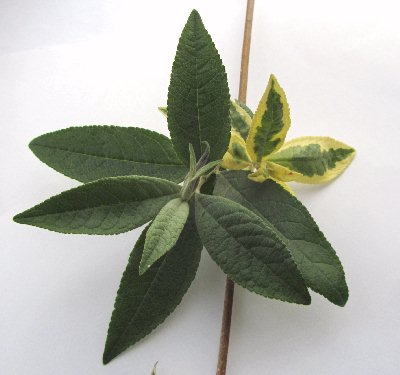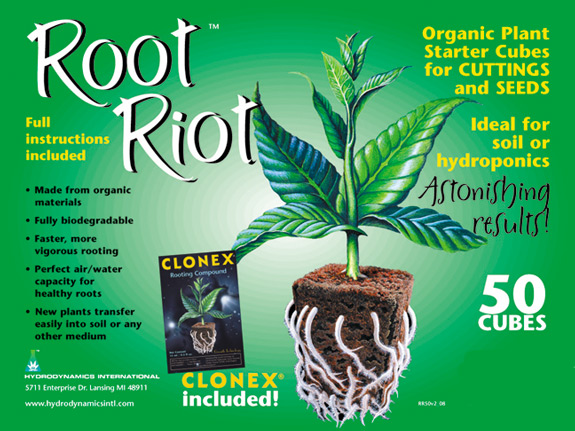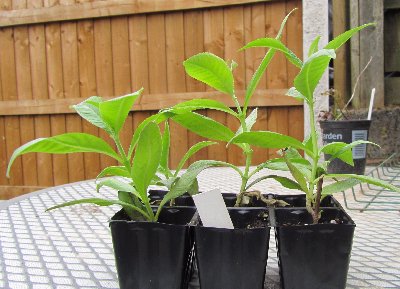
Buddleja davidii
- Growing Tips and Propagation
This advice applies to B. davidii cultivars and equally to the hybrids with B. fallowiana as well as all the B. x weyeriana hybrids. Most other Buddleja species require different treatment as they may be less hardy, flower and need pruning in a different season or need special conditions to thrive.
Planting Out
B. davidii cultivars are considered unfussy about soil type but they do prefer a free-draining soil. They require sun for at least part of the day and they won't tolerate deep shade. In areas with heavy clay it is probably best to improve the soil with plenty of compost and sharp sand or grit. Winter water-logging is the biggest danger, where roots can rot away. I usually dig a very deep planting hole, much deeper than the top soil and back fill with the sand/grit and compost as this helps with drainage. Many cultivars grow so quick they will become strong enough to cope with occasional water-logging. They also do like slightly alkaline conditions so lime can be beneficial and it helps the production of the hairs that produce grey foliage in some cultivars. Limestone (10mm) chippings that are used for drives can be introduced in the planting hole which both helps drainage and keeps the soil from becoming acid.
Most garden centres sell plants all year round in 2 or 3 litre pots. These are usually strong enough to be planted out straight away and the best time by far is late spring once the soil has warmed up. I have got into the habit of growing them much bigger in pots before planting out as I have particularly heavy soil. It takes a very short time in spring and summer for a 3 litre plant to grow to fill a 15 litre pot. Once they are this size they are much more robust for the winter and can be planted out much later in the year, as late as August.
Pruning and Feeding
There is conflicting advice out there on when, how and how much to prune your Buddlejas. Anyway, they are forgiving plants and can usually recover from mistaken harsh treatment. But to get the best from them it pays to get the pruning right. The best time for the pruning is just as they start growing strongly again after the winter. The exact time varies according to where you are and the weather but on average that will be from about mid-March to early April. They should never be cut right down before winter or too early in the year as they will be excessively weakened. Also, a reasonable leaf area helps them cope with the wet winter soil.
This is not to say that they cannot be tidied up after flowering and prior to winter. It is a very good idea to fully dead-head to avoid a million little seedlings appearing next year and also reduce the height of the plant slightly to avoid winter wind-rock that can snap the trunk or damage the roots.
It's a matter of opinion how much to cut them back in the spring as they will re-grow from a stump but generally cut down to knee height for smaller cultivars and young plants, maybe only to waist height for older and larger shrubs. Caution should be exercised when pruning the variegated cultivars as the new growth is prone to reversion, which is to say that the leaves revert to a plain un-variegated green. They tend to be less strong growing anyway and should always be left with sufficient buds and foliage to maintain the variegation. If a green shoot appears it is much more vigorous and soon outgrows the rest of the shrub; it's essential to remove these quickly and thoroughly. I usually cut back to the entire stem but normally it is only necessary to rub (rather than cut) the shoot away.
Winter mulching is a good idea. Spent mushroom compost is brilliant for this, but any compost will do. A couple of centimetres deep is enough to encourage a healthy fauna in the soil such as earthworms, which will help with the aeration and drainage. In acid soils a little lime added to the compost will both suit the Buddlejas and increase the worm population.

An example of reversion in the cultivar Variegata, notice that the green shoot is much more vigorous.
There is more advice on the How to Prune Buddleja davidii page

Vitax Q4 or similar fertiliser is good but expensive
Feeding is best done in the spring straight after pruning. Although they can grow with minimal nutrients, they need additional feeding to produce the best flowers. A general purpose high potash (potassium) feed is best - the additional potash helps with flower development and wood maturation. Good quality rose food or Vitax Q4 are recommended but expensive. They contain essential nutrients such as magnesium, iron and trace elements together with NPK (nitrogen, phosphate and potassium) in the best ratio for woody shrubs (NPK 5.3 - 7.5 - 10.0). Cheaper rose foods often lack the trace elements such as molybdenum, manganese and boron that are essential micro-nutrients so check the analysis carefully. A cheaper alternative is blood, fish and bone with added home-made wood-ash or supplemented with sulphate of potash. Fish, blood and bone does contain higher nitrogen which, in excess, can result in a lot of soft growth rather than sturdy, woody growth so should be avoided unless the potash content is significantly increased.
The correct amount to give depends on how rich the soil is but in general about a large cup-full per plant is should be sufficient. The fertiliser can be applied as a top dressing or lightly raked into the soil at the base of the plant. Liquid feed is also suitable and can be used throughout the growing season to support flowering. Tomato feed is high in potash and is ideal.
When they are flowering, usually from early July, it is advisable to remove all the dead flowers every few days. If the seed capsules start developing the formation of new flowers will be suppressed as the plant directs all its energy into seed production. Regular dead-heading prolongs the flowering period with a second and even a third flush of flowers into September, although as the season progresses the flower panicles do get smaller. Those first flowers in July are always the biggest and the best.
Growing New Plants from Cuttings
B. davidii and most other Buddleja species are easy to propagate from cuttings. The cultivars do not come true from seeds and taking cuttings is the best way to clone a plant. There are different ways to do these cuttings depending on several factors. The material is best when planted immediately and from a well irrigated plant. This ensures what is called turgidity or turgor pressure, meaning that the cells are supported by hydrostatic pressure. If there is a necessary gap between cutting and planting then the material should be stored in a plastic bag with a dampened tissue or the cut end placed in water like a cut flower.
The compost used has a big impact on the rooting success. It must be free-draining - multi-purpose with 30% sharp sand and 20% perlite is good, but some people have success with 100% perlite or vermiculite. I would also recommend using foam sponges such as Root Riot that are used in hydroponic propagation. These are expensive but have a very high success rate.

Clonex Rooting Hormone and Root Riot sponges are an expensive option but give a very high strike rate. Similar products are also available from other companies. These are readily available from Hydroponics shops and Ebay.
In spring fresh shoots can be used as material to strike cuttings. They need to have a growing tip and several leaves. Remove all but the final mature pair of leaves carefully with a clean, sharp knife. Trim the shoot to leave one stripped leaf joint and at least a centimetre of stem below the joint. If you are using rooting hormone dip it in up to the leaf joint. However, opinion is divided about rooting hormone and Buddleja will usually strike (form roots) without. Rooting powders such as 'Strike' contain 1-naphthyl-acetic acid and I have found this to have a lower success rate than no hormone. Gel rooting hormone preparations containing indole-3-butyric acid are much more effective. Clonex and similar products also contain nutrients to aid rooting. Whichever you choose it is best to follow the product's instructions. I have been told honey is also a good rooting aid and it is naturally anti-fungal to prevent rot. Always use a small dibber or stick to make a hole in the compost to avoid damaging the cut end or wiping off all the rooting compound.
However you choose to propagate hydration is paramount. Misting is a helpful and using a heated propagator with high humidity is also good with sponges or cells. Pots are ideally covered with a clear plastic bag supported with a couple of sticks. A warm window sill, greenhouse or cold-frame are all good sites but don't go for full sun as this will scorch or over-heat the plant at this vulnerable stage. On really sunny days it may be necessary to shade the cuttings. The rooting sponges have a clear advantage over pots cells: as soon as roots start growing they show through the sponge matrix and this can happen within 2 weeks or less in a propagator. then the whole sponge can be potted up with minimal root disturbance.
If you are not using sponges you should pot the plants on when the cuttings have rooted. You can tell this as they will start producing fresh growth. If you have a single cutting in a pot or cell then just pot it on into a larger volume. Multiple cuttings in a single pot will need to be split and re-potted as soon as it is clear they are growing, but this carries a risk of root damage as they are split up. Spring cuttings grow quickly and they will certainly be big enough to flower the same summer.
Spring is the best time for propagation, but cuttings can be made at anytime except winter. Once Buddlejas have formed flower buds or are in flower cuttings become marginally more difficult to root as the tissues are geared towards flower/seed production. It is therefore essential to remove the tip of the cutting with the flower to get the cutting to strike. The plant will still grow from the buds at the previous leaf joint. It is possible to continue to take cuttings right up until autumn but by this time semi-ripened wood is likely to give better results. Cuttings taken at this point will need winter protection in an unheated greenhouse.
It's a mistake to keep the cuttings too protected. I've kept a precious cuttings in the house over winter, and they don't like it. They can fail to flower the next summer as they don't receive the signal that they have been through a winter and should be forming flowers. Disease and pests can be a problem, especially spidermites which are normally killed off by the winter.

Trim off the lower leaves from a fresh shoot such as that in the top image keeping a single mature pair. Have one trimmed leaf joint and at least a centimetre of stem below the leaf joint (black arrow) to plant under the surface as this is where most roots will form from the undifferentiated cells in the stem. Ensure the end cut in clean by using a very sharp knife, (red arrow).
As an aside, I would say that many gardeners simply stick a Buddleja twig in the ground in the summer and, lo! and behold, they have a new plant next spring. If this works for you, fine. I prefer to keep a track of the process and not trust to luck. A few cultivars, such as 'Summer Beauty', can be very hard to root successfull. Using this method, if I need to propagate a specific cultivar I only have to do one cutting, or maybe two, to be sure of having a viable plant.

New little plants ready to pot on!
Email:
buddlejagarden@gmail.com
© The Buddleja Garden 2011-2025.